Speech Funding the Resources Investment Boom
As you're all well aware, the Australian resources sector has been undergoing a historically large investment boom. Investment spending in the sector has grown from just under 2 per cent of GDP to around 8 per cent currently.
Today, I am not going to talk about the direct macroeconomic impact of this, which has been extensively described elsewhere by my colleagues.[1] Instead, I will focus on how the investment has been financed. In doing so, I will draw extensively on a recent article published in the RBA Bulletin by Ivailo Arsov, Ben Shanahan and Tom Williams.[2]
Their work highlights the fact that the investment boom has been financed almost entirely from the balance sheets of the companies doing the investing. That is, it has been cash-financed from earnings. There has been very little borrowing associated with the investment spending, and to the extent that there has been any, it has generally been directly from capital markets rather than intermediated through the banking sector.
Another important aspect of the financing is that it has constituted a sizeable capital inflow for the Australian economy. This in turn has had implications for the composition of Australia's balance of payments and also the exchange rate.
The Resources Investment Boom
I will start by describing some of the main features of the investment boom.
Between 2003 and 2012, investment in new projects and expansions of existing capacity in the resources sector is estimated to have totalled $284 billion, according to ABS data. A detailed analysis of project-level data on the projects completed since 2003, or still underway at the end of 2012, suggests that Australian companies have accounted for just over half of this (54 per cent), with the balance coming from foreign entities.[3] Here I am counting BHP and Rio Tinto as Australian companies.
The overwhelming majority, over 90 per cent, of the investment has been by publicly listed companies (Graph 1). The investment has been predominately in iron ore, coal, oil and gas (mainly LNG), with these four commodities accounting for 84 per cent of the investment in physical infrastructure during the boom.
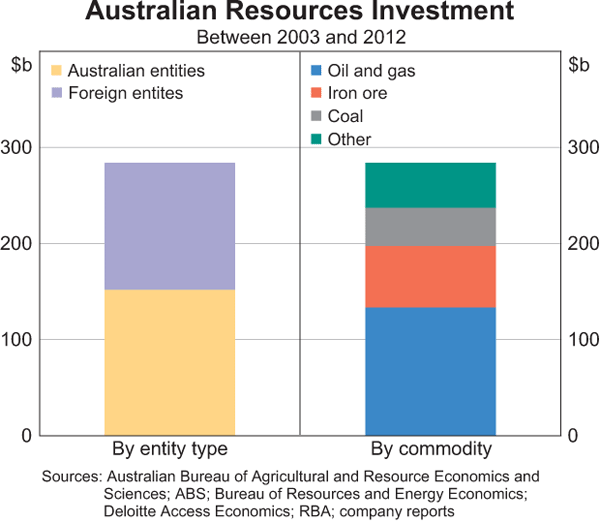
Funding the Boom
Given that the vast bulk of the investment has been carried out by listed companies, we were able to use the financial statements of the relevant companies, both Australian and foreign, to estimate how the investment was actually funded. This exercise involved examining the financial accounts of all the listed Australian resources companies (around 900) and 37 foreign companies.
This analysis shows that since the start of the resources boom in 2003, Australian companies have raised no equity in net terms. While they raised substantial amounts of equity in 2009, the Australian companies have been returning greater amounts of capital to shareholders since 2011. The foreign companies have been consistently returning large amounts of capital to their shareholders, and, as a group, have not resorted to external equity funding during the resources boom.
The funds raised by these resources companies have been used overwhelmingly to make new physical investments, with Australian and foreign companies using around 80 per cent of their funding for this type of spending (Graph 2). The rest of the funding has been used primarily to acquire existing assets from other companies, while funding for other investment purposes has been negligible.
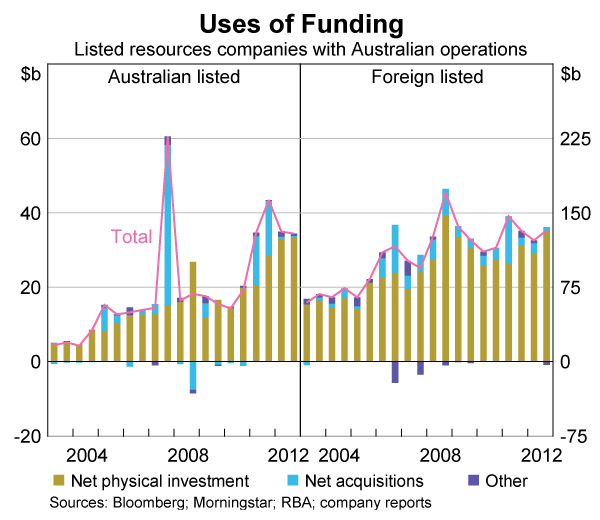
In general, companies' funding is fungible. However, certain types of funding are more suited to specific purposes. In particular, this is the case for acquisitions that are usually large relative to the acquirers' balance sheets, and require large one-off payments. These types of transactions are often funded with syndicated loans. Given their distinct funding requirements, funding for these acquisitions has been excluded. That is, debt raised to fund takeovers is excluded from the subsequent analysis.
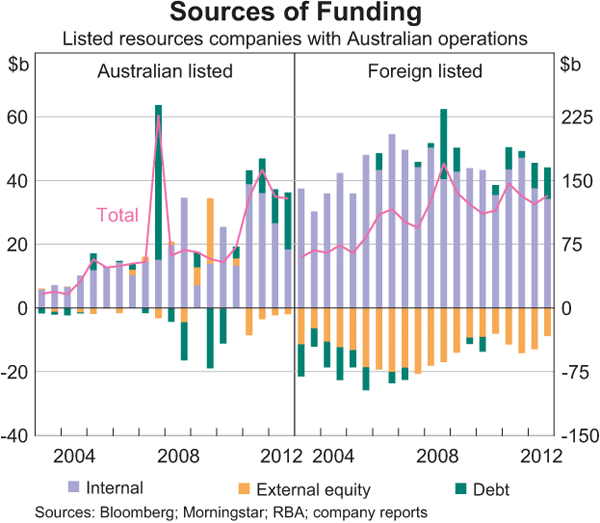
In terms of the sources of funding, the analysis shows that 80 per cent of investment spending by Australian-listed resources companies, and over 90 per cent by foreign companies, has been funded through internal sources (Graph 3 and Table 1). Operating cash flow has been the predominant source of internal funding, made possible by the historically high level of commodity prices throughout the period.
| Australian entities | Foreign entities | All entities | |
|---|---|---|---|
| Listed companies | 49 | 43 | 93 |
| Of which: | |||
| Internal funding | 40 | 40 | 79 |
| – Current operations | 38 | 39 | 77 |
| – Existing cash | 1 | 1 | 2 |
| Debt funding | 9 | 4 | 12 |
| – Bonds | 6 | 3 | 8 |
| – Loans | 3 | 1 | 4 |
| Equity funding | 1 | 0 | 1 |
| Private companies | 3 | 1 | 3 |
| Government entities | 1 | 2 | 4 |
| Total | 54 | 46 | 100 |
|
(a) Numbers may not add up exactly due to rounding
Sources: Australian Bureau of Agricultural and Resource Economics and Sciences;
ABS; Bloomberg; |
|||
To the extent that these companies have resorted to external sources of funding, this has been mainly in the form of bonds issued directly into capital markets. Very little has been funded by borrowing from banks. The companies have tapped bond markets rather than banks in part because of the longer tenors available in the bond market which match the long investment horizons of these projects. Another reason is that a number of these resources companies are able to access financial markets at a cheaper price than the banks themselves can.
This absence of borrowing from the banking sector is one of the reasons why (intermediated) business credit in Australia remains relatively subdued despite the around trend growth in the Australian economy in recent years. It also means that unlike previous investment booms in Australia's history, this one has been associated with very little leverage.
The other notable fact from Table 1 is that the funding for the Australian resources boom has been sourced extensively from overseas. At face value, given the share of foreign companies involved, the analysis implies that around half of the investment during the boom has been funded from offshore. However, the actual use of foreign sources of funds is much higher than that. This is because wherever companies are partly foreign owned, funding from internal sources is equivalent to partial funding from foreign sources. Consequently, since the Australian listed resources sector is around three-quarters foreign owned, the same large proportion of internal funding is attributable to foreign sources. For instance, the three-quarters foreign ownership of BHP implies that three-quarters of BHP's internal funding is recorded as foreign. Taking all this together suggests that around four-fifths of the investment funding has been sourced from offshore.
So while the focus of the effect of the resources sector on the balance of payments has been on its effect on imports of capital goods for the investment and on the export revenue generated, there has also been a material impact on the capital flows to Australia, which I will now discuss.
The Effect on Capital Flows
The impact of the above developments has been reflected in the Australian balance of payments (BOP) data, which indicate that foreign capital flows into the Australian resources sector have grown from an average of around 1 per cent of annual GDP in 2007 to around 3½ per cent in 2012.[4]
This constitutes a significant change in the composition of capital flows in the Australian economy; one of three noteworthy changes in recent years.
In the decade prior to the global financial crisis, around two-thirds of foreign capital flows into Australia was directed to the financial sector, amounting to an average inflow of around 6½ per cent of GDP over this period. Since 2007, as I have noted on other occasions,[5] inflows into the banking sector have declined considerably to the point where the banking sector has been a net repayer of offshore borrowing (Graph 4).
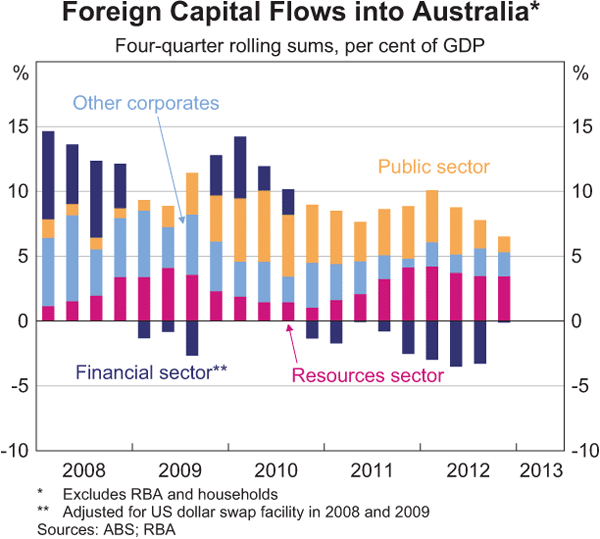
At the same time, foreign purchases of Australian government debt have increased significantly, which has seen the foreign ownership share of Commonwealth Government securities increase from 50 per cent to around 70 per cent currently, even as the stock of issuance has risen fivefold.
Both of these two large changes in the composition of capital flows directly relate to the upheavals in global financial markets over the period.
In contrast, the large increase in capital flows to the resources sector is not related to the financial crisis – being obviously a direct product of the resources boom, which is itself a function of the large increase in commodity demand from emerging markets.
In thinking about the effect of capital flows on the value of the Australian dollar, it is important to take account of all of these changes in capital flows. Simply focusing on the developments in only one particular type of capital flow can give a partial picture of what is going on. Moreover, I have not talked at all here about changes in the outward flows of capital. While these flows are also large, over the period in question here, changes in their size have not been so noteworthy.
So in terms of the effect on the Australian dollar, of the three major changes in capital flows we have seen over the past six years, two of them: the capital inflow to the resource sector to fund investment along with the increased purchases of government debt, have been putting upward pressure on the currency. But at the same time, the reduction in offshore borrowing by the banking system has been putting downward pressure on it. The net effect of all these flows however, is that the Australian dollar is higher than one would expect, given fundamentals such as the terms of trade and interest differentials.
Turning to another effect of the pattern of resources investment funding on Australia's balance of payments, as noted above, around 75 per cent of the foreign direct investment in the resources sector since 2007 has been in the form of reinvested earnings. In the balance of payments statistics, a proportion of the profits earned by resources companies accrue to foreign shareholders and contribute to Australia's net income deficit (NID; a part of the current account deficit). If the profits on these direct investment holdings are reinvested, this constitutes a corresponding direct investment ‘inflow’ captured in the capital account surplus. In this way the activities of the resources sector are, to some extent, ‘grossing up’ the figures in the capital account and the NID (Graph 5 shows this relationship for the economy as a whole). That is, the reinvested earnings are recorded as a capital inflow, even though the money remains in Australia. As a result, the recorded current account deficit and corresponding net capital inflow are larger than the actual cross-border flows of funds associated with this investment.
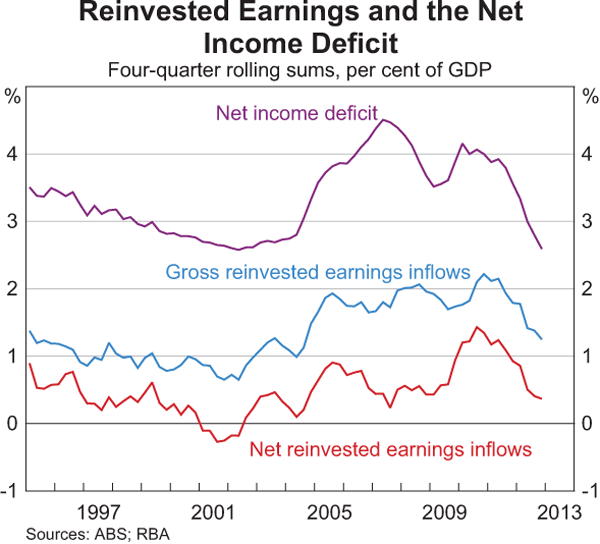
Conclusion
The historic investment boom in the resources sector has not only had a significant impact on the real side of the Australian economy, it has also had a material effect on the financial side. In my talk today I have highlighted two noteworthy aspects of this:
- Firstly, unlike most other parts of the economy, the investment by resources companies has been almost entirely self-funded from internal cash flows. Very little of it has been funded through the banking sector.
- Secondly, because a large share of the resource sector is foreign owned, this internal funding has been reflected in large capital inflows into Australia in the form of foreign direct investment. This has had an impact on both the capital and current account sides of Australia's balance of payments.
Endnotes
Thanks to Ivailo Arsov, Ben Shanahan and Tom Williams for all their work and to Rachael McCririck and Florian Weltewitz for their help with the balance of payments data. [*]
See, for example, Bishop J, C Kent, M Plumb and V Rayner (2013), ‘The Resources Boom and the Australian Economy: A Sectoral Analysis’, RBA Bulletin, March, pp 39–49. [1]
Arsov I, B Shanahan and T Williams (2013), ‘Funding the Australian Resources Investment Boom’, RBA Bulletin, March, pp 51–61. [2]
Arsov et al describe the exact methodology that has been used here. [3]
The ABS began publishing an industry breakdown of capital flows data in September 2006. [4]
Debelle G (2011), ‘In Defence of Current Account Deficits’, Address at ADBI/UniSA Workshop on Growth and Integration in Asia, Adelaide, 8 July. [5]
